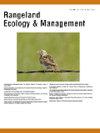评估保护准备情况:萨格布鲁什生物群落战略保护的地点、对象和方式
IF 2.4
3区 环境科学与生态学
Q2 ECOLOGY
引用次数: 0
摘要
鼠尾草生物群落正在迅速恶化,这主要是由于针叶林的扩张、更频繁和更大规模的野火以及入侵性一年生草的扩散对生态系统造成了威胁。扭转这些威胁的影响是一项艰巨的挑战。萨格布鲁什保护设计(Sagebrush Conservation Design,SCD)强调,有限的保护资源应首先用于维护核心萨格布鲁什区(Core Sagebrush Areas,CSA),然后在可能的情况下扩大这些区域。SCD 强调了维护和战略性发展 CSA 在生态方面的重要性。然而,这些区域已被确定这一事实并不意味着保护工作可以立即进行或将取得成效。在鼠尾草生物群落中进行战略性保护不仅涉及在具有重要生态意义的地区开展工作,还必须明确认识到个人和组织在决策时所处的社会和行政条件。因此,我们建议,只有在 "保护准备就绪 "的地域,即生态重要性、社会能力和有利的行政条件相互交错的地域,才能开展战略性的持久工作。我们提供了一个评估保护准备就绪程度的框架,它既是一个清单,也是一个诊断工具,在突出当前资产的同时,也揭示了需求以及将创建或维持保护准备就绪程度的活动类型。我们展示了 "保护准备就绪框架 "在确定地方、中间和区域各级的不同角色和活动方面的实用性,这些角色和活动必须在一定时期内培育保护准备就绪状态。在实践中,这种方法与单纯以生态重要性为驱动力的管理方法形成了鲜明对比,并说明了有效的保护还必须包括有针对性的工作,以改善社会和行政条件。本文章由计算机程序翻译,如有差异,请以英文原文为准。
Assessing Conservation Readiness: The Where, Who, and How of Strategic onservation in the Sagebrush Biome
The sagebrush biome is rapidly deteriorating largely due to the ecosystem threats of conifer expansion, more frequent and larger wildfires, and proliferation of invasive annual grasses. Reversing the impacts of these threats is a formidable challenge. The Sagebrush Conservation Design (SCD) emphasized that limited conservation resources should first be used to maintain Core Sagebrush Areas (CSA), and then to grow such areas where possible. The SCD heightens the ecological importance of maintaining and strategically growing CSAs. However, the fact that these areas have been identified does not mean that conservation is immediately possible or will be effective. Strategic conservation in the sagebrush biome does not only involve working in ecologically important areas; it is an approach that must explicitly acknowledge the social and administrative conditions in which individuals and organizations are making decisions. We accordingly propose that strategic, durable work can only occur in geographies of “conservation readiness,” that is, where ecological importance, social capacity, and conducive administrative conditions intersect. We offer a framework for assessing conservation readiness that functions as both an inventory and diagnostic tool, highlighting current assets while shining a light on needs and the types of activities that will create or sustain conservation readiness. We demonstrate the utility of the Conservation Readiness Framework for identifying the different roles and activities that must occur at local, mid, and regional levels to nurture conservation readiness over time. In practice, this approach contrasts with management driven solely by ecological importance and illustrates that effective conservation must also involve targeted efforts that curate both social and administrative conditions.
求助全文
通过发布文献求助,成功后即可免费获取论文全文。
去求助
来源期刊

Rangeland Ecology & Management
农林科学-环境科学
CiteScore
4.60
自引率
13.00%
发文量
87
审稿时长
12-24 weeks
期刊介绍:
Rangeland Ecology & Management publishes all topics-including ecology, management, socioeconomic and policy-pertaining to global rangelands. The journal''s mission is to inform academics, ecosystem managers and policy makers of science-based information to promote sound rangeland stewardship. Author submissions are published in five manuscript categories: original research papers, high-profile forum topics, concept syntheses, as well as research and technical notes.
Rangelands represent approximately 50% of the Earth''s land area and provision multiple ecosystem services for large human populations. This expansive and diverse land area functions as coupled human-ecological systems. Knowledge of both social and biophysical system components and their interactions represent the foundation for informed rangeland stewardship. Rangeland Ecology & Management uniquely integrates information from multiple system components to address current and pending challenges confronting global rangelands.
 求助内容:
求助内容: 应助结果提醒方式:
应助结果提醒方式:


